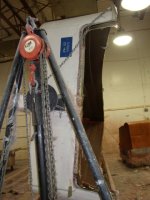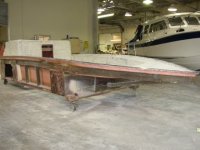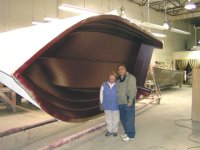journey on
New member
Since I suffered a transom crack in Journey On, I've been interested in how a C-25 is built, and couldn't find any photos of its construction.
Well, when Journey On was under construction, and we were making progress payments, I had Laura ( the daughter in Tumwater,) go up and shoot photos, and send them down. Ah, the modern miracles of electronics. And via the age-old miracle of the human brain, I then forgot them. Finally, I rebuilt one of our PCs and whilst getting it up and running, I ran across these three pictures.
First a shot of the hull showing the balsa layup area and the transom build up. The balsa in this shot goes up to about the V-berth. Also, I believe the green structure in the transom is the rigid foam they now use, so it was present in all boats made after 5/05. Note it stops short of the outboard end of the transom. That is the fiberglass transfers the loads into the sides of the hull.

Next is a shot of the transom area showing a different angle on the transom.

Last is a picture of the deck during layup. I don't know what this shows, but it's here for completeness.

Boris
Well, when Journey On was under construction, and we were making progress payments, I had Laura ( the daughter in Tumwater,) go up and shoot photos, and send them down. Ah, the modern miracles of electronics. And via the age-old miracle of the human brain, I then forgot them. Finally, I rebuilt one of our PCs and whilst getting it up and running, I ran across these three pictures.
First a shot of the hull showing the balsa layup area and the transom build up. The balsa in this shot goes up to about the V-berth. Also, I believe the green structure in the transom is the rigid foam they now use, so it was present in all boats made after 5/05. Note it stops short of the outboard end of the transom. That is the fiberglass transfers the loads into the sides of the hull.

Next is a shot of the transom area showing a different angle on the transom.

Last is a picture of the deck during layup. I don't know what this shows, but it's here for completeness.

Boris




